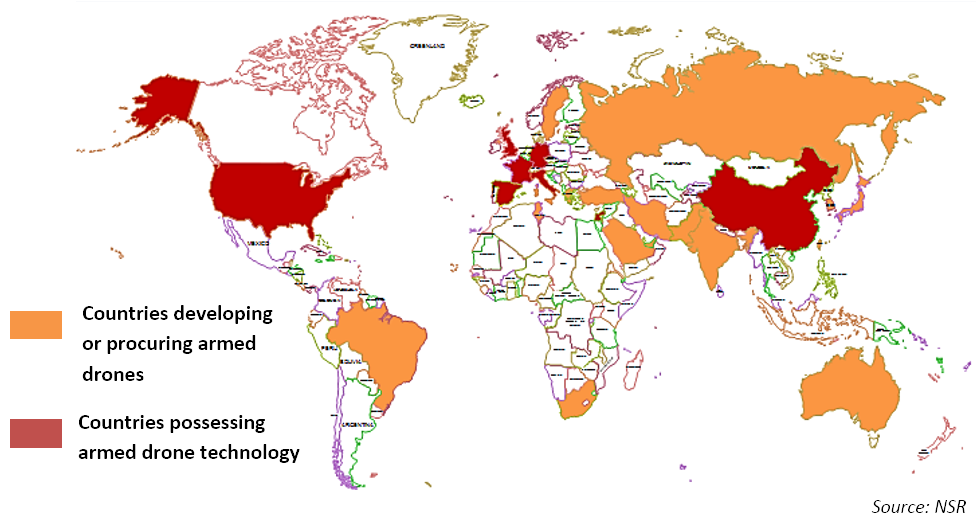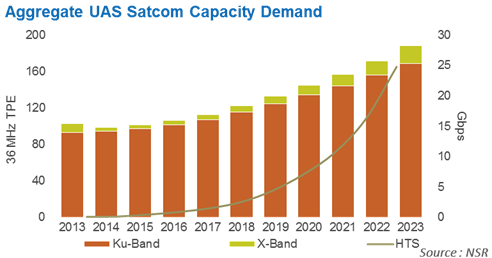Will UAS Market “Drone” on for Satcom?
Feb 26th, 2015 by
Prateep Basu, NSR
Despite shrinking military budgets, the U.S. DoD’s
plans for unmanned aircraft systems (UAS) will not diminish
anytime soon. Evidence of this trend comes via the recently
unveiled USAF RQ-180 program with Northrop Grumman, or the
involvement of U.S. airstrikes in military conflicts in
Middle-East countries such as Syria, Iraq and Yemen. The
U.S. is certainly not alone in pursuing a military drone program
with countries such as China, U.K., France, India, Japan,
Australia and Italy pushing strongly to develop and procure UAS
capabilities. Given the increasing role of satellites in
supporting UAS activities in all regions, one has to wonder if
this application could be a bright spot in an otherwise troubled
milsatcom market.
HALE UAS, especially the ‘Global Hawk’ and its
naval variant MQ-4C Triton, are the most sought after UAS
globally for their ISR capabilities, and Japan, South Korea,
Australia and India have lined up purchases of this UAS by
2017-18. The U.S., which is the largest producer of HALE and
MALE UAS, recently announced expansion of their sale to
‘Allied Countries’, amidst rising tension in global
trade from Israel and China. As news of an aggressive Chinese
drone export program surfaced, with rumors of UAS sales to Saudi
Arabia, Uzbekistan, Algeria, Pakistan and Myanmar, the developed
world was shaken out of its slumber regarding the prospects of a
deteriorating global peace situation, especially in developing
regions.
Continuing geo-political tensions in the
Middle-East and Eastern Europe have also catalyzed other Western
European countries to stack up the arsenal of UAS, with the U.K.
presently testing its combat purpose stealth drone ‘Taranis’
developed by BAE Systems, and France planning to buy General
Atomic’s ‘Reaper’ drones for $1.5 billion by 2016-17. With Asian
powers such as China, India, Japan, Indonesia already increasing
their defense expenditure to protect their territorial and
maritime sovereignty, the U.S. decision to ‘go soft’ on
allies for sale of combat and strike drones provides a case for
a substantial UAS fleet build-up across the globe in the coming
decade. NSR expects the growth in HALE and MALE UAS
airframes globally to be more than twice that of current numbers
by 2023.

What Is In It For Satellite Operators?
The explosive growth expected in the HALE and MALE
UAS market translates into a major role for commercial satellite
operators to play. As the past decade has shown, satellite
bandwidth for UAS operations is a critical resource that
government satellite programs alone cannot provide. In the
backdrop of the expected increase in the number of UAS airframes
across the globe, NSR’s recent Unmanned
Aircraft Systems via Satellite report predicts that
commercial satellite capacity demand for UAS operations will
increase significantly during the period 2013-23,
with FSS Ku-band leading the way due to the high
latency on the governmental front in overhauling the existing
UAS designs and existing ground systems, which primarily make
use of this frequency band.

With high definition live video becoming the most
sought after UAS application, NSR expects the usage of
GEO-HTS (both Ka-band and Ku-band)
for UAS operations to increase rapidly by the end of
this decade, since it allows higher data rates to
smaller antennas, and its beam characteristics reduce the
chances of signal jamming or cyber-attacks. The combined demand
for Ku-band, GEO HTS, and X-band satellite bandwidth has a
revenue generation potential upward of $700 million by 2023 from
capacity leasing, and close to $2 billion through UAS Satcom
equipment sales for the Defense &
Intelligence markets alone.
The Bottom Line
The proliferation of large UAS platforms across
the globe presents a unique opportunity for commercial satellite
operators to capitalize upon, due to the high revenue generation
potential of this market. NSR expects the role of both
government and commercial bandwidth to increase equally in UAS
programs globally, and that means more demand for satellite.